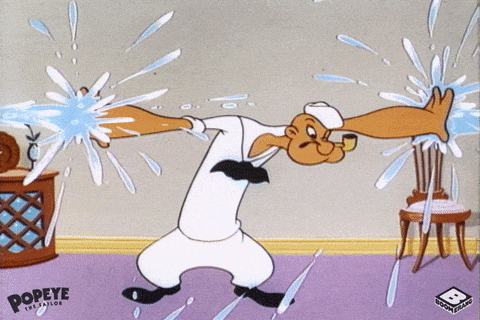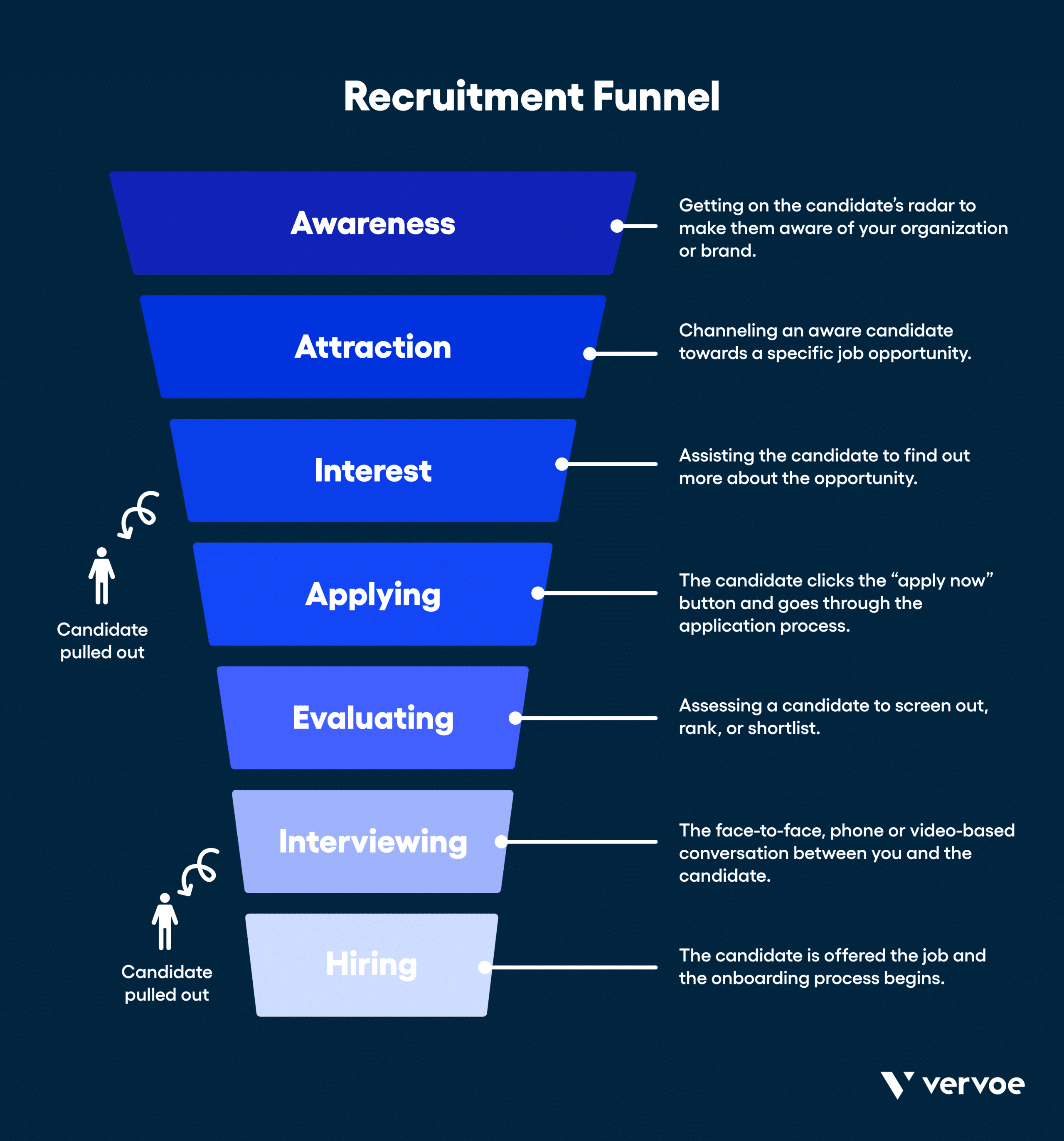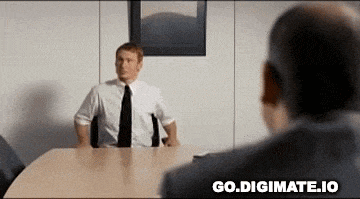What is a recruitment funnel?
Recruitment funnels are a useful tool to help recruiters and talent teams visualize every step in the recruitment process from attraction to hiring. Ideally, the process involves capturing as many potential leads as possible at the wide mouth of the funnel and narrowing the pool until you are left with one or more top-quality candidate(s).
Breaking the selection funnel into several stages is a great way to understand where you are spending most of your time in recruitment, and where you need to invest more energy. A common mistake is to put plenty of effort into the bottom of the funnel (shortlisting, interviewing, and hiring) but not doing enough at the top of the funnel.
Understanding your recruitment funnel in its entirety will help you think strategically about talent attraction, with the ultimate benefit of setting up a robust pipeline that will continue to deliver.
Recruitment funnels are leaky
Don’t get me wrong; I love a good kitchenware analogy. But the funnel imagery needs a slight correction if it’s going to work. While kitchen funnels have solid sides (making them the perfect tool for avoiding a sticky mess when pouring), a recruitment funnel has holes in it, a bit like a colander.

Why does this matter? Because not every candidate that enters the top of your funnel-colander will end up coming out the narrow end. Nor should they; the point is to take a large group and whittle it down to a shortlist of potential hires.
There are two ways candidates can leave your funnel before they get to the end:
- They decide to drop out: Candidate attrition can occur at every stage of your recruitment funnel and is usually caused by a poor candidate experience.
- You screen them out: The purpose of the hiring funnel is to reduce candidate numbers to a small group of top performers and (ultimately) a single hire. After all, it’s a funnel, not a tube.
In this guide, we’ll explore tips for keeping candidate attrition to a minimum at every stage of the funnel.
Recruitment funnel stages
The recruitment funnel, also referred to as the hiring funnel, has seven main stages, shown below:
- Awareness: Getting on the candidate’s radar to make them aware of your organization or brand.
- Attraction: Channeling an aware candidate towards a specific job opportunity.
- Interest: Assisting the candidate to find out more about the opportunity.
- Applying: The candidate clicks the “apply now” button and goes through the application process.
- Evaluating: Assessing a candidate to screen out, rank, or shortlist.
- Interviewing: The face-to-face, phone, or video-based conversation between you and the candidate.
- Hiring: The candidate is offered the job, and the onboarding process begins.

Stage 1: Awareness
The first stage of the recruitment funnel involves building awareness amongst potential talent pools that your organization is a great place to work.

Improve your brand recognition
Brand recognition begins with the basics: getting people to recognize your organization’s name and logo. As a jobseeker scrolls through hundreds of online job advertisements, a known brand name will stand out amongst all the other unknown company names, and will increase the likelihood of a click.
Keep your recruitment marketing high-level and focus on building awareness that your company is a great place to work. Remember, this stage should not be about funneling people towards a specific job opportunity yet.
If you’re lucky enough to work for a well-known brand or household name, you may find that the first stage of the funnel is already taken care of. It’s possible that the public may know your company for its products or services, but people don’t generally think of you as a potential employer. If so, it’s time to ramp up your employer branding efforts.
Build your employer brand
Employer branding means getting the message out there that your organization is a great place to work. Here are some tips for building a strong employer brand:
- Identify what makes your organization a special place to work and broadcast these features to stand out from the crowd. These could be job perks, strong company values, or the team culture.
- Optimize your digital presence to make your organization highly visible to remote candidates in other cities or countries.
- Building and maintaining a great career site or “Work with us” page on your company website.
- Partner with marketing to ramp up your organization’s social media presence.
- Creating videos showing happy, engaged (and real) team members at work.
- Encourage your team to become word-of-mouth advocates for your organization.
What success looks like: Getting on a potential candidate’s radar as an organization they would one day consider working for.
Stage 2: Attraction
The next step in your talent acquisition funnel is to attract job seekers towards a specific job opportunity.

Write a stand-out job description
Countless job descriptions are uploaded around the world every day. Here are some tips for making yours stand out:
- Don’t rush! Investing time, thought, and effort into a job description will pay dividends in the long term. Don’t cut and paste or republish outdated job descriptions.
- Put the job’s best perks or features at the very top of the page (don’t bury it five paragraphs down). This could be the salary, flexibility, or team culture.
- Keep the document short and succinct. Avoid turning off candidates by asking for too much.
- Avoid overly formal language or jargon. Speak directly to the reader (“you”).
- Show what the company can do for the candidate.
- Use mixed media such as embedding a “day in the life” video.
- Make sure the tone of the job description matches your organization’s voice and brand.
- Publish the salary range. A LinkedIn study found 61% of candidates believe the salary range is the most important part of a job description.
- Be clear about the next steps.
Check out Vervoe’s tips on writing a perfect job description here.
About that leaky funnel: poorly written job descriptions that are too long, too vague, too formal, or biased will cause candidates to exit your candidate recruitment funnel. At the same time, however, job descriptions are an opportunity to discourage unqualified candidates from applying. Consider including a short section on “Why this opportunity may not be right for you”.
Create videos about specific roles
If you’ve already created a generic work-with-us video, the attraction stage provides an opportunity to get more specific about a particular role. You can then publish the video on your careers page, social media channels, and (importantly) embedded in the relevant job description.
This approach suits large organizations that hire multiple people for the same role.
Advertise where your candidates are
There’s little point in creating a killer job description if the right people don’t see it. Getting targeted with job ads will help reduce the chances of their being lost in the noise.
Consider demographics, sectors, and professions before investing in targeted advertising. Perhaps the candidates you seek prefer a particular social media platform or industry-specific online job boards. For some professions, trade publications and newspapers are still the go-to for job ads.
What success looks like: Bringing a job opportunity to a potential candidate’s attention and stimulating their interest in learning more.
Stage 3: Interest
Up until this stage, the top of the hiring funnel has involved pushing information to passive candidates to build awareness and attraction. In the “interest” stage, however, candidates will take action for the first time by researching your organization and potentially getting in touch with any questions.

Your role in this stage is to ensure your digital presence is optimized and provide candidates with everything they need to help them decide to apply.
Strengthen your reputation as an employer
Think about what a candidate will discover when they start researching your organization. What comes up in a Google search? Are you happy with what they will discover on your social media channels: on LinkedIn, Twitter, Instagram? Is your careers page (and entire website, for that matter) as good as it can be?
The worst scenario is when interested candidates make an effort to research your organization only to discover a poor digital presence, such as an outdated website or abandoned Twitter account. Worse, they may discover negative information such as disgruntled former employee reviews on Glassdoor or unhappy customer reviews on Amazon.
Put yourself in the shoes of an interested candidate, open Google, and start searching. Make a list of everything you’d like to improve about your digital presence to ensure candidates are not turned off at this stage of the funnel.
Provide candidates with as much information as possible
Brainstorm questions candidates may have about your organization, the application process, or the job opportunity, but don’t try to shoehorn all the answers into the job description.
Instead, create an easy-to-find resource for candidates to locate answers to their questions. The simplest form of this is an FAQ page, but if you’ve got the money and time to do so, consider investing in a chatbot.
A word of warning: frustrated candidates may exit your recruitment funnel if they can’t quickly find the answers they need. It’s therefore important to provide some sort of contact or help desk option that will connect them with a real person. This can be a major expense in a high volume situation. Still, a positive interaction by phone may be the factor that convinces a potential candidate to apply on the plus side.
Some companies create videos as a compelling way to answer common questions, such as this explanation of the hiring process from Google:
What success looks like: Candidates are impressed with what they discover when researching your organization. Any questions are answered quickly and satisfactorily.
Stage 4: Applying
Congratulations! Getting a candidate to the application stage is a major milestone in the recruitment funnel. All of the work you did in terms of building awareness, attraction, and interest has culminated in the candidate clicking the “apply now” button.
But the job application itself is a notorious attrition point for candidates dropping out. In fact, a Recruiter.com survey revealed an abysmal average completion rate of 10.6%.
Therefore, your focus in stage four should be to build a best-practice application process that drives high completion rates and creates a great candidate experience.

Get the application process right
We’ve all experienced the frustration of clunky online job applications. Typically, they involve setting up an account, uploading a résumé, uploading a separate cover letter, entering information that is duplicated in your résumé, fiddling with file sizes and file formats, the list goes on.
A Careerbuilder survey found 60% of job seekers drop out of job applications because they’re too lengthy or too complex. Here are some ways to increase the conversion rate of your applicants:
- Ensure the application is optimized for mobile devices.
- Don’t ask too many questions.
- Avoid confusing or complex language.
- Complete the application yourself to time the process and spot any problem areas.
- Analyze user data to pinpoint any questions that cause applicants to drop out.
- Consider skipping the résumé and using a skills test instead.
How long is too long? Set yourself a challenge to streamline your job application to keep it under five minutes with a maximum of 25 questions.
Keep candidates informed
Never “ghost” candidates! If they have gone to the effort of completing your application process, the least you can do is send them a confirmation email or text.
Ideally, this communication should thank them for their time, let them know what to expect in terms of the next steps, and expected timelines. If the process is delayed, let them know.
Use candidate messaging automation (usually integrated with your ATS) to make this a breeze, but be sure to inject a bit of personality into the messages to try to retain the human touch.
What success looks like: Continuous improvement of the job application process to reduce drop-offs, and keeping candidates informed with streamlined, automated communication.
Stage 5: Evaluating
Let’s say you’ve received 350 applications but only have the resources to interview ten candidates. How will you screen out 340 candidates while ensuring the group you interview are the top performers?

Use the right selection methods
The right candidate selection methods can help recruitment teams make tough decisions throughout the hiring process. Getting it wrong, however, can lead to unconscious bias and inadvertently screen out great candidates.
Résumé screening
Despite its popularity, résumé screening simply doesn’t work for several reasons:
- Candidates lie on their résumés.
- Candidates may be great at writing an impressive résumé but not great at the job you plan to hire them for.
- Academic credentials and professional background are ineffective predictors of future job success.
- Manual résumé screening is time-intensive and is subject to inherent bias.
- Automated résumé screening is subject to bias.
- Automated résumé parsing by qualifications, experience, or keywords can inadvertently screen out great candidates.
You get the point. You can use résumé screening to whittle hundreds or thousands of applications down to a manageable number. Still, there’s little guarantee that they will be the best candidates of the group that originally applied.
Skills testing
Skills testing is a way to see how candidates do the job, before they get the job. Organizations should first understand the skills or attributes that drive top performance in a role, then test all applicants in the recruitment funnel for those skills. A data analyst, for example, could be tested in critical thinking, the use of data models in different situations, and data classification for different problem sets.
The result? All applicants who complete a skills test will be ranked and scored. This not only allows you to progress the best candidates with confidence but also shows the candidates’ strengths and weaknesses to explore further at the interview stage.
Other types of pre-employment testing
There are several other forms of pre-employment testing, many of which fall under the umbrella term “psychometric testing”. These include job knowledge tests, personality tests, integrity tests, emotional intelligence tests, and cognitive ability tests.
Prioritize the candidate experience
Like the job application process, candidates will drop out of your recruitment funnel during the testing phase if they have a poor experience. Avoid this by:
- Keeping the candidate well informed about the process and being prepared to answer questions.
- Ensuring tests are not too long, too hard, or too easy.
- Using a mix of formats (text-based, multiple-choice, and video-based).
- Easing into it by starting with easier questions and building in difficulty.
- Including example answers to assist candidates.
Check out Vervoe’s guide to best practice skills assessments here.
Beware of bias
As any recruiter or talent professional will tell you, this stage of the recruitment funnel is a minefield in terms of unconscious bias. There are no fewer than 12 kinds of hiring biases to manage, mitigate, and avoid.
Luckily, there are several strategies for avoiding bias, including merit-based skills testing, blind hiring, focusing on consistency, having a diverse hiring team (if assessing candidates manually), and avoiding introducing bias into recruitment AI.
What success looks like: You identify a small group of top-performing candidates to progress to the interview stage. You receive positive candidate feedback about the skills testing/evaluation experience.
Stage 6: Interviewing
By this point, the hiring funnel is starting to narrow. You’ve put in a great deal of effort attracting, interesting, evaluating, and whittling down candidate numbers to a small group of top-performers. Don’t undo all your great work with a sub-standard interview process.

Let skills test results guide your interview strategy
There’s very little time in an interview to gather all the information you need to make a major hiring decision, so it’s important to use that time wisely.
If the candidate has completed a skills test, use the results from that test to avoid duplication; or testing for skills you already know they have. Instead, dig into the results to look for weaknesses and probe the candidate in those areas. You may also choose to use the time on things that were not included in your assessment, such as determining the candidate’s potential cultural fit or values alignment.
Ensure remote interviewing is as good as in-person
The future of work is remote. The present is remote, too (I’m in lockdown as I write this), but it’s clear that organizations are increasingly trending toward remote or hybrid working environments. This has led to the rise of the remote interview and several associated challenges for companies and candidates.
Create a great remote candidate experience by keeping them well-informed, being just as professional as you would in a face-to-face interview (don’t cancel meetings last minute, dress appropriately), and testing equipment to reduce the chance of interruptions.
For remote roles, be sure to ask the candidate questions to gauge their remote working effectiveness, their ability to self-start, manage their own time, collaborate remotely, and more.
Beware of bias (again)
Interviews are another stage in which bias can occur unless it is managed carefully—combat bias by having a diverse interview panel and avoiding one-to-one interview situations. Create an interview scorecard and standardize interviews to establish an even playing field. Avoid hiring based on likeability or “gut feel”.
Communicate, communicate, communicate
Candidates that have reached the interview stage deserve to be kept informed whether they are successful or not. Reach out immediately after the interview to thank them for their time, inform them of expected timelines, and let them know what the next steps are likely to be.
Be empathetic and encouraging when letting candidates know they were unsuccessful. Remember, the holy grail of candidate experience is when a candidate exits the recruitment funnel with a positive impression of your organization, even though they didn’t get the job.
What success looks like: You gather enough information in the interview process to make a decision (combined with skills test results) about which candidate will be offered the role. Although they are disappointed, unsuccessful applicants have had a positive candidate experience.
Stage 7: Hiring
After you’ve completed reference and background checking, send the candidate a compelling offer that includes any benefits that are important to them. Top candidates are likely to have offers from other businesses, so it pays to put a bit of effort into the job offer itself. Candidates may be flattered to hear what it was that impressed you, such as being told they received the highest test score across hundreds of applicants.
Once they’ve accepted the offer, launch straight into your onboarding program to keep new hires engaged and excited in the period between offer acceptance and their first day on the job.

Drive continuous improvement
You’ve made it to the end of your recruitment funnel. It was a wild ride, but the job doesn’t end when you hire a new employee. Collect candidate feedback and recruitment funnel metrics to drive continuous improvement in as many stages of the funnel as possible.
You may choose to send a generic candidate experience survey to everyone who applied for the role, or you could dig deeper. For example, if a candidate drops out halfway through your skills test, an email could be generated asking them why. Similarly, you could ask candidates (both successful and unsuccessful) for feedback on the interview experience.
Final thoughts: Employee Advocacy
Taking a step back, it’s clear that the recruitment process becomes more defined from Stage 4: Applying. From that point, you’ve captured the candidates’ data, and they begin a guided journey through the remainder of the funnel with the assistance of process automation.
The top of the recruitment marketing funnel is trickier. It can be hard to measure success and know what actions to take to improve candidate attraction and interest.
The number one tip is to tap your current pool of employees to turn them into advocates. The stats are mind-blowing: messages have a 561% greater reach when shared by employees rather than by official brand channels; posts shared by employees get 800% more engagement, and 76% of individuals say they’re more likely to trust content shared by employees over content shared by brands.
This video from YouTuber Caroline Anne about how to get hired at Starbucks – and the benefits of working there – generated over 150,000 views and undoubtedly helped Starbucks improve the top of its hiring funnel and candidate journey.




















